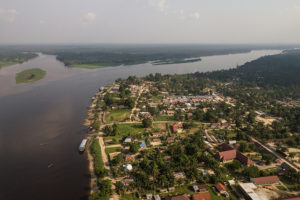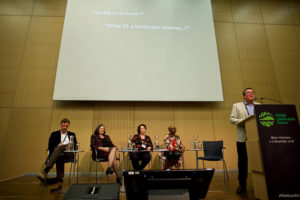Over the past six years, conversations on sustainable forest management activities focused on transforming the way the international community addresses poverty, food insecurity, climate change and biodiversity loss have coalesced into the Global Landscapes Forum (GLF) movement.
Based on the landscape approach, the GLF aims to synthesize seemingly competing land-use goals to ensure social, environmental and economic equilibrium. In a nutshell, both the GLF and the approach address the pressures of population growth and human demand, which exacerbate agricultural expansion and intensification, and the extraction of commodities, including wood, vegetable oils and biofuels.
At a recent GLF conference in Bonn, Germany, scientists discussed implementation of the landscape approach during a panel discussion titled Looking at the Past to Shape the Landscape Approach of the Future, moderated by Terry Sunderland, senior associate with CIFOR and a professor at Canada’s University of British Columbia.
The session was inspired in part by the findings of a research paper led by CIFOR scientist James Reed, titled “Integrated landscape approaches to managing social and environmental issues in the tropics: Learning from the past to guide the future.”
Watch: Looking at the past to shape the Landscape Approach of the future
New funding from Germany’s Federal Ministry for the Environment, Nature Conservation and Nuclear Safety (BMU) for CIFOR and partners to move beyond theoretical discussions to implement and study landscape initiatives in Burkina Faso, Indonesia and Zambia also formed the basis for discussions.
“Moving from commitment to action is critical,” said Sunderland, who was instrumental in forming the GLF, which is now jointly coordinated by CIFOR – the lead center of the CGIAR Research Program on Forests, Trees and Agroforestry (FTA) – UN Environment and the World Bank, and funded by BMU and Germany’s Federal Ministry for Economic Cooperation and Development.
Sunderland was also a lead author on the seminal research paper “Ten principles for a landscape approach to reconciling agriculture, conservation and other competing land uses,” which established the basis for ongoing conversations.
“We need to start moving beyond the talking, beyond the rhetoric and actually moving towards implementation,” Sunderland said. “We need to shift away from the theoretical, away from the political, away from the development speak and into much more pragmatic understandings of how landscape approaches play out on the ground.”
Panelists shared lessons learned from various initiatives that have embraced the landscape approach.
RESOURCE FLOWS

Musonda Mumba, chief of the Terrestrial Ecosystems Unit at UN Environment, demonstrated the interconnectedness of landscapes. Through observations of glacier activity in the Rwenzori Mountains on the border between Democratic Republic of Congo and Uganda, she came to understand the scale of the impact activities could have downstream and beyond country borders.
“Look at the Rwenzori system – if you go on the world map and the Africa map in particular, you’re going to see that most of the rivers that emanate from this region flow down into Lake Victoria, and eventually into the Nile River system,” she said. “And how many people live in the Nile basin? It’s millions, right? It’s a lot of people.”
She made similar findings from research in Peru. Because the capital Lima is a desert city, it depends on the maintenance of upstream sources to provide hydroelectricity and fresh water supply for more than 10 million people, Mumba said.
In 2015, significant international pacts were sealed, including the Paris Agreement on climate change, the Sendai Agreement on Disaster Risk Reduction and the U.N. Sustainable Development Goals (SDGs). These formal agreements provide vital frameworks formalizing the interconnectivity of landscapes, Mumba said.
SDG 15, Life on Land, is the mother of all SDGs, she said. “We cannot exist without the land and our food systems are based on the land — You cannot slice up the landscape. A landscape is so intricately and complexly interwoven together.”
Read more: Putting the concept of the ‘landscape approach’ into action
SCALING UP

Mirjam Ros-Tonen, associate professor at the University of Amsterdam in the Netherlands, explored local-level, small-scale initiatives to test their potential to become broader scale landscape projects.
She evaluated agroforestry cocoa projects in Ghana involving reforestation and landscape restoration, which provided income for smallholder farmers. She learned that the projects were contained on the farm.
“Partnerships are needed to extend the activities to landscape level and partnerships are needed to give farmers a voice and offer them opportunities for self organization and autonomous change,” Ros-Tonen said. “See if you can build on local initiatives, and from there build partnerships with other actors in the landscape.”
After working on at least 50 large-scale integrated landscape initiatives, similar patterns showed the need for multi-stakeholder platforms that can plan and conceptualize a long term joint vision over a number of decades, said Sara Scherr, president and chief executive of EcoAgriculture Partners, adding that the process can take from six months to three years.
Implementation involves adhering to five key steps, including expansion of the stakeholder network, securing financial backing and an assessment process. Collaborative planning projects need a long-term vision.
“You need a cadre of people champions in the landscape from pharma organizations, agribusiness, local governments, national governments, cultural leaders, the people who were committed to the vision of the transformed landscape who will work together,” Scherr said.
It is important to look beyond labels in use and focus on assessing progress over the longer term, noting that such approaches ought to be thinking far beyond the typical project cycle, she added.
External input is a vital part of achieving success in integrated landscape initiatives, said Roderick Zagt, program coordinator at Tropenbos International. While people he worked with understood the problems they faced and the consequences of various activities, they can benefit from external perspectives.
“We aren’t in the driving seat,” Zagt said. “We can’t impose that vision, but I think as an outsider you should try to set the conditions by which this vision will be reached through a structured dialogue process.”
Read more: The concept and development of the ‘landscape approach’
Overall, panelists agreed that landscape approaches must be long term, locally owned endeavors, although their effectiveness is often dependent on external sources of support, Reed said.
“The general consensus was that the GLF should provide a clearing house mechanism to consolidate experiences and knowledge,” he added. “Its future mission could serve to enhance and clarify the evidence base, providing guidance on implementation strategies and lessons learned in the quest for truly sustainable landscapes.”
By Julie Mollins, originally published at CIFOR’s Forests News.
This research forms part of the CGIAR Research Program on Forests, Trees and Agroforestry (FTA), which is supported by the CGIAR Trust Fund.
This research was supported by German Environment Ministry and German Development Ministry.











